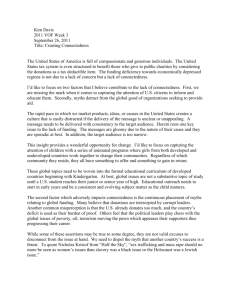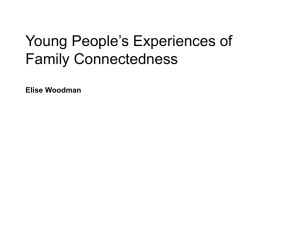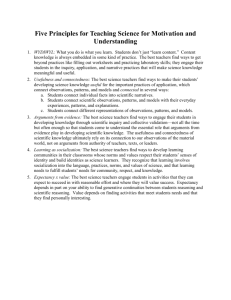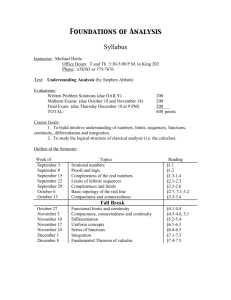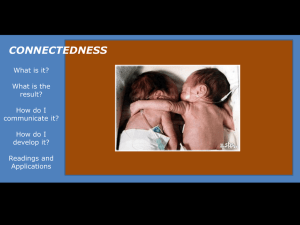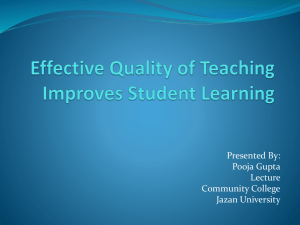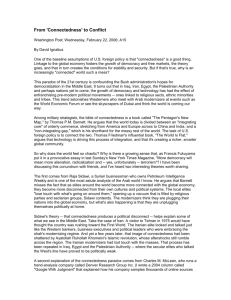F RESEARCH
advertisement
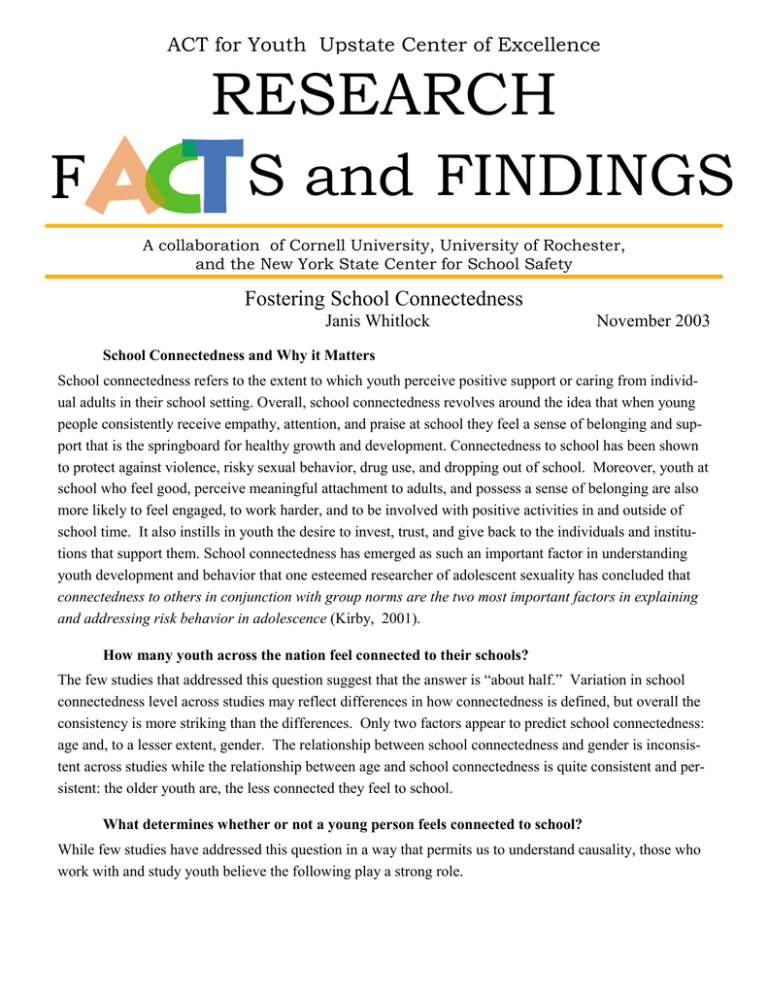
ACT for Youth Upstate Center of Excellence F RESEARCH S and FINDINGS A collaboration of Cornell University, University of Rochester, and the New York State Center for School Safety Fostering School Connectedness Janis Whitlock November 2003 School Connectedness and Why it Matters School connectedness refers to the extent to which youth perceive positive support or caring from individual adults in their school setting. Overall, school connectedness revolves around the idea that when young people consistently receive empathy, attention, and praise at school they feel a sense of belonging and support that is the springboard for healthy growth and development. Connectedness to school has been shown to protect against violence, risky sexual behavior, drug use, and dropping out of school. Moreover, youth at school who feel good, perceive meaningful attachment to adults, and possess a sense of belonging are also more likely to feel engaged, to work harder, and to be involved with positive activities in and outside of school time. It also instills in youth the desire to invest, trust, and give back to the individuals and institutions that support them. School connectedness has emerged as such an important factor in understanding youth development and behavior that one esteemed researcher of adolescent sexuality has concluded that connectedness to others in conjunction with group norms are the two most important factors in explaining and addressing risk behavior in adolescence (Kirby, 2001). How many youth across the nation feel connected to their schools? The few studies that addressed this question suggest that the answer is “about half.” Variation in school connectedness level across studies may reflect differences in how connectedness is defined, but overall the consistency is more striking than the differences. Only two factors appear to predict school connectedness: age and, to a lesser extent, gender. The relationship between school connectedness and gender is inconsistent across studies while the relationship between age and school connectedness is quite consistent and persistent: the older youth are, the less connected they feel to school. What determines whether or not a young person feels connected to school? While few studies have addressed this question in a way that permits us to understand causality, those who work with and study youth believe the following play a strong role. 2 Parental attachment and early childhood experiences A strong relationship with parents is an important factor in priming young people to feel connected to school during their middle and high school years. Early in life, primary caregivers provide children with important sources of support, esteem, and efficacy. Youth with histories of parental neglect or violent behavior during the elementary school years are less likely to feel connected to school later (Karcher, forthcoming), possibly because their ability to approach new relationships in a positive and supportive way has been compromised. These children are more likely to be labeled as “troubled” from the beginning and are less likely to attract the positive support and attention needed to form positive connections. School Climate A recent study of an upstate New York State community found that school climate mattered far more than other elements of a young person’s life (gender, parental income, race, religiosity, or academic standing) in explaining school connectedness. School climate encompasses the following: a) the opportunity to affect school classroom policies and procedures, b) positive relationships with adults, c) the perceptions that adults as a whole at school did not discriminate based on appearances, and d) opportunities for creative engagement. Virtually all of the most powerful predictors of school connectedness were those related to school climate. In this study, youth participants also evaluated their degree of connectedness by assessing the extent to which school rules and policies communicated care, value, respect and trust. This is why some youth reported having supportive attachments at school to individual adults (or peers) still report not feeling connected to school. This seemed especially important for older youth who were far more sensitive to power imbalances and the ways in which school policies were designed to control their behavior as opposed to support their growing need for autonomy (Whitlock, 2003). Another study based on a much larger sample of 127 schools from the Add Health database found a similar pattern. Supportive youth-adult relationships and opportunities to assume meaningful decision-making roles were the most powerful predictors of connectedness. In schools with zero tolerance policies, which mandate harsh punishment for first infractions, students felt less connected and less safe at school. Small school size, but not class size, was important as well. Interestingly, school connectedness was lowest in racially integrated schools and highest in schools with little racial or ethnic integration. Although surprising, this finding is consistent with other studies and suggests that it may have to do with the way friendships are patterned in integrated schools (McNeely, 2002). Conclusion There is a growing body of evidence to support the assumption that schools have an important developmental role to play in producing more than just positive academic outcomes. When youth feel connected to school they are buffered from risks that jeopardize their health and social development. Understanding what promotes school connectedness is a relatively new field of study. What we know from current research supports what teachers and others who work with youth know: positive relationships with adults and opportunities to influence not only what happens in class, but school structure, policies, and rules, matter for youth well-being and productivity. This is particularly important for youth who are the least likely to be connected and successful at school or in other important settings, as they are at the greatest risk for problems during adolescence and later in life. 3 Implications Based on our current knowledge of the importance of school connectedness, implications for policy and practice include the following: Create opportunities for youth of all ages to be included and involved on as many levels as possible Promote school-community partnerships aimed at integrating learning and community participation opportunities; Strengthen youth-adult relationships by creating opportunities for youth and adults to work alongside each other, assuring that every young person in school is noticed by at least one adult, and encouraging adults not to use their status as adults unfairly; Recognize and accommodate grade-related differences in the things that matter most in cultivating connectedness; Actively recruit high-risk and/or low achieving youth for involvement in school engagement opportunities; Create formal structures or forums for youth representatives to solicit input from their youth constituents. References Blum, R. W., & Rinehart, P. M. (2001). Reducing the risk: Connections that make a difference in the lives of youth. Minneapolis, MN: Division of General Pediatrics and Adolescent Health, University of Minnesota, Box 721, 420 Delaware St., S.E. Karcher, M.J. (forthcoming). Connectedness and School Violence: A Framework for Developmental Interventions. Handbook of School Violence. Hansworth Press Kirby, D. (2001). Understanding what works and what doesn't in reducing adolescent risk-taking. Family Planning Perspectives, 33(6), 276-281. McNeely, C., Nonnemaker, J.M., Blum, R.W. (2002). Promoting school Connectedness: evidence from the National Longitudinal Study of Adolescent Health. Journal of School Health 72(4), 138-146. Whitlock, J. (2003). Voice, visibility, place and power: Correlates of school and community connectedness among 8th, 10th, and 12th grade youth. Unpublished doctoral dissertation, Cornell University. The Upstate Center of Excellence invites you to visit the ACT for Youth web site at: http://www.human.cornell.edu/actforyouth Additional copies of this newsletter and many other resources in the youth development field are available in pdf format on the ACT website. The Upstate Center of Excellence also hosts a moderated listserve. You may join the listserve by sending an email to listproc@cornell.edu. Leave the subject field blank and type the following command in the body of the message: subscribe ACT-L yourfirstname yourlastname. ACT for Youth Upstate Center of Excellence Cornell University FLDC ~ Surge 1 Ithaca, NY 14853 Phone: 607.255.7736 Fax: 607.255.8562 Please help us maintain the accuracy of our mailing list. If you’re receiving more than one copy, or if there's an error in your name or address, please let us know. Thanks!
